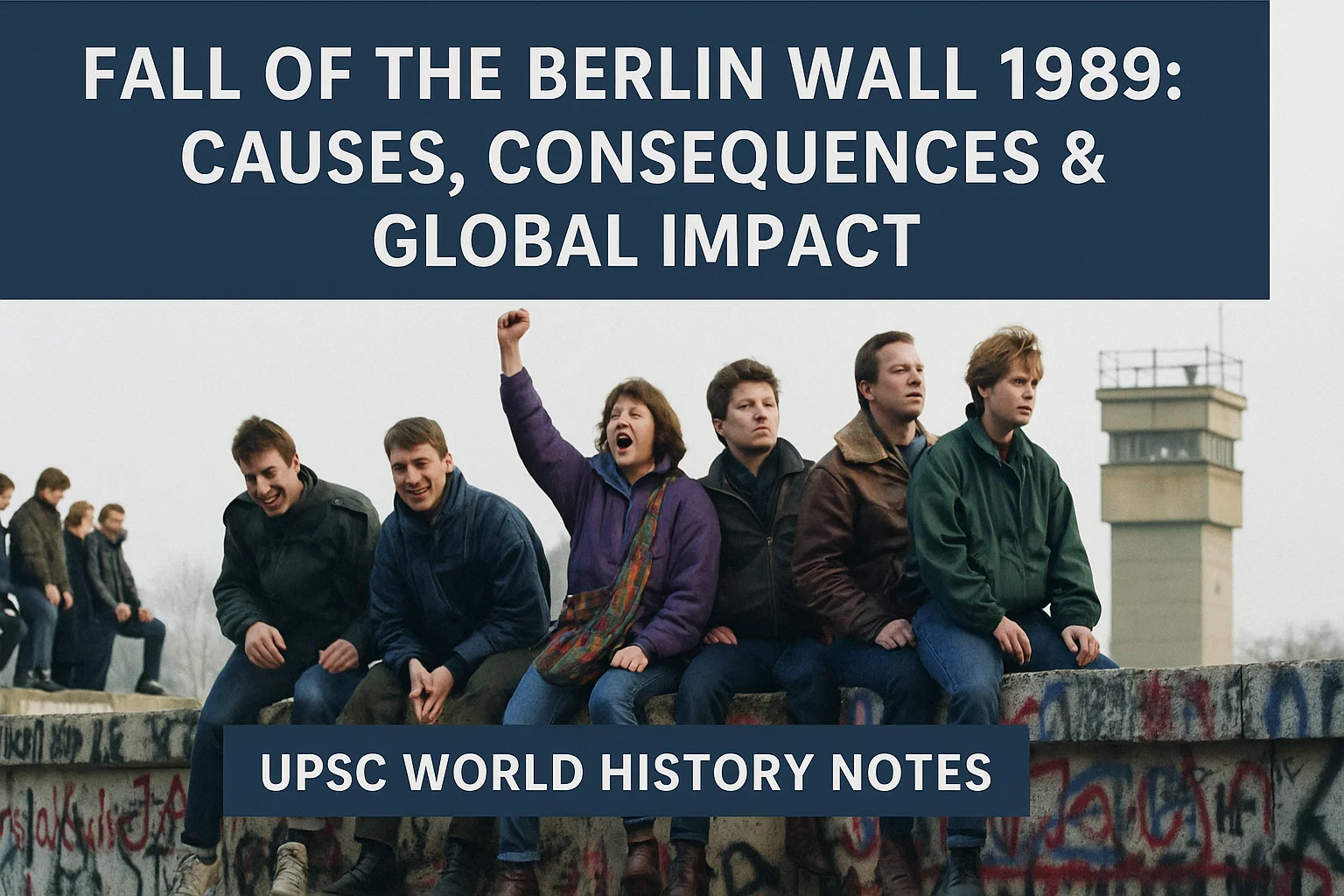Fall of the Berlin Wall 1989: Causes, Consequences & Global Impact | UPSC World History Notes
Learn about the Fall of the Berlin Wall (1989) — its causes, immediate triggers, and global repercussions. Understand how this event ended the Cold War, accelerated the collapse of the Soviet Union, reshaped world politics, and transformed India’s foreign policy. A comprehensive guide for UPSC World History and IR preparation.
Fall of the Berlin Wall 1989:
On November 9th, the fall of the Berlin Wall in 1989 stands as a watershed moment of the 20th century, which not only symbolised the end of division in Germany but also triggered the collapse of the Iron Curtain, leading to the disintegration of the Soviet Union and a fundamental shift in the global geopolitical order.
What was the Berlin Wall?
- The Berlin Wall was a guarded concrete barrier that physically and ideologically divided the city of Berlin from 1961 to 1989.
- Constructed by the German Democratic Republic (GDR, or East Germany), it encircled West Berlin, cutting it off from the surrounding East German territory.
- The wall was not a single structure but a complex system of concrete walls, anti-vehicle trenches, guard towers, and “death strips” equipped with floodlights and armed guards with shoot-to-kill orders.
- It served as the most potent symbol of the Cold War—the division between the communist East, led by the Soviet Union, and the democratic West, led by the United States.

Why was it erected?
- The Berlin Wall was erected by the East German government on August 13, 1961, to stem the mass exodus of its citizens to West Germany.
- Between 1949 and 1961, an estimated 2.5 million East Germans, many of them young, skilled professionals, had fled to the West, primarily through the open border in Berlin.
- This “brain drain” was economically crippling and a massive propaganda defeat for the communist regime.
- The wall was designed to halt this emigration and to stabilise the East German state by forcibly imprisoning its own population.
Why did it fall?
The fall of the Berlin Wall was the result of a confluence of factors:
- Internal Pressure: Decades of economic stagnation and political oppression in the Eastern Bloc led to growing dissent.
- By 1989, mass pro-democracy protests, particularly in East Germany (the Monday Demonstrations) and Poland, were challenging the communist regimes.
- Gorbachev’s Reforms: The new Soviet leader, Mikhail Gorbachev, introduced policies of Glasnost (openness) and Perestroika (restructuring).
- He renounced the Brezhnev Doctrine, signaling that the USSR would no longer use military force to prop up satellite states in Eastern Europe. This removed the fear of a Soviet crackdown.
- Immediate Trigger: On November 9, 1989, amidst confusion and mounting pressure, an East German official, Günter Schabowski, mistakenly announced that travel restrictions to the West would be lifted “immediately, without delay.”
- This led to thousands of East Berliners gathering at border crossings. Overwhelmed and without clear orders to use force, the guards opened the gates, leading to a spontaneous and joyous celebration that effectively marked the wall’s end.
How did it lead to the disintegration of the Soviet Union?
The fall of the Berlin Wall had a domino effect that directly contributed to the Soviet Union’s collapse:
- Loss of the Eastern Bloc: The event catalysed the rapid collapse of communist governments across Eastern Europe in 1989-90 (Poland, Hungary, Czechoslovakia, etc.). This dismantled the Soviet Union’s strategic buffer zone and sphere of influence, a core element of its superpower status.
- Ideological Discrediting: The peaceful fall of the wall demonstrated the failure of the communist system to its own people. It shattered the legitimacy of the Communist Party of the Soviet Union (CPSU), inspiring independence movements within the various Soviet republics.
- Acceleration of Internal Forces: The event emboldened Baltic and other republics to push for independence. It also weakened Gorbachev’s position, leading to a failed hardliner coup in 1991, which ultimately precipitated the formal dissolution of the USSR in December 1991.
How did this event change the world order?
The fall of the Berlin Wall fundamentally reshaped the global order:
- End of the Cold War: It marked the symbolic end of the Cold War, concluding decades of bipolar confrontation between the US and the USSR.
- US Hegemony and Unipolar Moment: The collapse of the Soviet Union left the United States as the world’s sole superpower, leading to a “unipolar moment“ in world affairs.
- Expansion of NATO and the EU: The integration of former Eastern Bloc countries into Western institutions like NATO and the European Union redrew the political and security map of Europe.
- Triumph of Liberal Democracy: It was widely seen as a victory for liberal democracy and market capitalism, an idea famously encapsulated in Francis Fukuyama’s “The End of History” thesis.
How did this event change the stance of the Indian Foreign Policy?
The fall of the Berlin Wall and the subsequent end of the Cold War forced a significant recalibration of Indian foreign policy:
- End of Non-Alignment: India’s foundational policy of Non-Alignment, which sought to navigate a middle path between the US and Soviet blocs, lost its relevance in a unipolar world.
- The Economic Imperative: Facing a severe balance of payments crisis and the loss of its primary strategic and trading partner (the USSR), India was compelled to reorient its economy and foreign relations. This led to the landmark economic reforms of 1991 and a “Look East” policy to engage with Southeast Asia.
- Rapprochement with the US: India began actively building a new strategic partnership with the United States, moving away from its previous Soviet-leaning stance. This paved the way for deeper defence, economic, and technological ties in the decades that followed.
Subscribe to our Youtube Channel for more Valuable Content – TheStudyias
Download the App to Subscribe to our Courses – Thestudyias
The Source’s Authority and Ownership of the Article is Claimed By THE STUDY IAS BY MANIKANT SINGH




